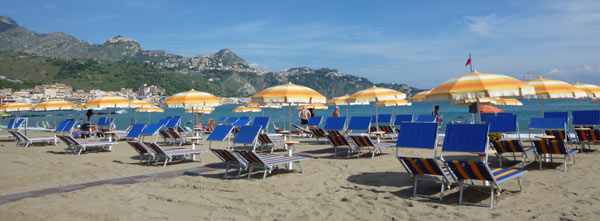Giardini Naxos is a seaside resort strung along a wide bay below the famous mountainside resort Taormina on the eastern coast of Sicily. Its setting is picturesque, and although the little town is not particularly elegant or exciting, it’s a cheery place in the tourist season, with superb views of Taormina and the Sicilian hills.
- Sicily destinations and practicalities: full menu (at foot of this page)
With a very ancient history, Giardini Naxos is a destination where you can explore Greek ruins, relax on the beach, enjoy a boat trip or catch a bus up to Taormina.
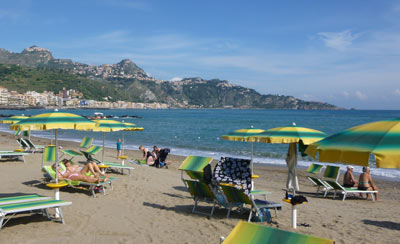
Much of what Giardini Naxos has to offer can be seen by taking a stroll along the long seafront road. Here you can book a boat trip, relax on the sand, rent your own boat, admire the views, swim or enjoy a meal at one of the many sea-view restaurants. Look out for a couple of Roman granite columns, which were discovered in the sea nearby.
Most of the tourist businesses are at the southern end of the town, where you’ll find a cluster of hotels and Giardini Naxos’s widest stretch of beach. Here you’ll find a choice of nicely-presented beach establishments where you can rent sunbeds or eat at the attached restaurants and bars. Before choosing your preferred lido, compare their atmosphere and offerings as well as their prices; some are smarter than others, and they may offer different features such as a little children’s playground. There is also plenty of free-access beach along the waterfront, though most of the beach is narrow and not necessarily as clean as the private areas.
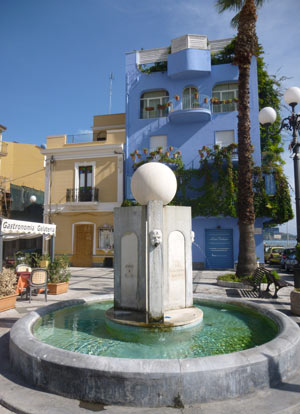
For many, the resort’s attractions are the beach and the proximity to Taormina, combined with cheaper accommodation prices. But the town does have a handful of sights of its own as well. If you’re staying in Giardini Naxos, you may find it interesting to visit the historic Castello di Schisò, towards the port at the southern end of town. Once a fortress defending the settlement on this headland, it later became a base for the sugar-processing industry and then an aristocratic home, and is now being restored and opened to the public by a cultural association. At the time of writing just a few rooms and the courtyard can be visited (admission charge); these are mildly interesting, and include a long chamber which was once, before it was enclosed, the rampart along the battlements. The courtyard is an appealingly decrepit and evocative spot, with the ruins of the sugar-processing buildings on one side and cats sneaking through broken doorways. In an internal room look out for the Romanesque crosses carved into wooden beams.
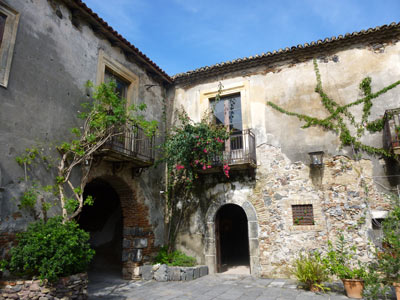
Giardini Naxos may not seem remarkable now, but historically it’s extremely important. It was the site, according to ancient writers, of the first Greek colony in Sicily, Naxos, established before other cities which are now better remembered: Syracuse, Agrigento, Selinunte. What is left of Greek Naxos can be visited in an archaeological park and museum at the southern end of the modern town on the headland called Capo Schisò. This was the site of the colonial city; an extensive site which was was used as farmland and not excavated properly until relatively recently, with excavations still under way.
It takes some time to follow paths through the site, and the ruins are not terribly dramatic compared with Sicily’s more famous Greek sites. But the atmosphere and the green, rural surroundings, make this a pleasant place to wander and evoke the past. The sight of Etna rising above lemon trees, pines, grass and ruined walls is a dramatic one. Information boards around the site try to make some sense of the visible ruins but really the best thing to do is stroll and absorb the general atmosphere. Low ruined walls still define the layout of ancient thoroughfares and houses, and visitors can walk down a ‘street’. The most substantial ruins are stretches of the city wall, with imposing stone gateways still in place.
To help see the site in context, visit the museum by the entrance before exploring. The museum presents information in Italian and English, and contains an interesting assortment of local finds, from pottery fragments to statuettes wearing the enigmatic archaic smile. A marble altar dedicated to the goddess Enyo with a script similar to that used in the Greek Cycladic islands has provided evidence of a connection between Sicilian Naxos and the Greek island Naxos, always said to have been the home of the earliest settlers who named this colony. Other interesting exhibits include a doll with jointed limbs from the 5th century BCE, an altar carved with two winged sphinxes and a bronze Thracian helmet decorated with hair and ears.
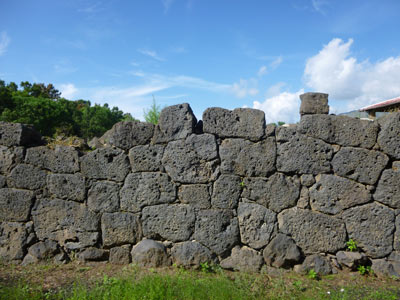
The archaeological park and museum are managed by the Parco Archeologico Naxos-Taormina, along with the Greek Theatre in Taormina and Isola Bella at Mazzaro. At the time of writing there are combined tickets for the park and Isola Bella. The site is open daily with hours varying through the year.
Out at the tip of the headland beyond the archaeological park is another little cluster of bar-restaurants. The town’s pride in its ancient Greek origins can be seen everywhere : a sculpture trail of sculptures inspired by Greek mythology, including a statue of Nike, a little ‘temple’ construction and of course the ‘Naxos’ part of the placename.
The local tourist information office can be found next to Hotel La Riva, on the stretch of seafront between the port and the town’s striking 20th-century church, Santa Maria Immacolata. This is a good place to pick up bus timetables and useful information for making the most of your stay.
Boat trips set off several times a day in season, organised by different companies, mostly from the port, with tours along the coast to Isola Bella and the local Grotta Azzurra (Blue Cave), allowing time for a brief dip in the sea. It’s also possible to book coach excursions to see some of the inland sights in this part of Sicily.
Giardini Naxos isn’t a particularly romantic or ‘special’ destination in itself. But it’s an affordable alternative to the more elegant Taormina and has the advantage of its beachside setting. For a seaside holiday with easy access to sightseeing and transport, it’s an option that will suit many travellers. As well as very local trips to Taormina, Castelmola and Mazzaro, it’s also easy to plan trips further afield: to Etna, Catania and beyond, without the need to hire a car.
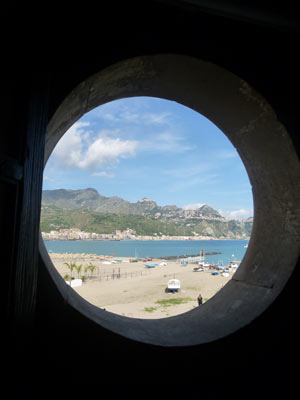
Giardini Naxos travel and transport
Giardini Naxos is on the eastern coast of Sicily, very close to Taormina. The most convenient airport is Catania. There are direct buses from the airport (also stopping in central Catania, with the final destination of Taormina). Services are run by Etna Trasporti/Interbus and are approximately hourly, with the journey taking an hour and fifteen minutes. There are several stops in Giardini Naxos, so check with your accommodation which stop you should request. Fares are cheap and timetables can be seen on the Interbus website (see links panel on the right). When staying in the resort you can use the same bus service or additional local Interbus services to reach Taormina, twenty minutes away.
Taormina and Giardini Naxos share a railway station, called Taormina-Giardini, on a line which runs down the coast of Sicily from Messina to Siracusa. The station is at the northern end of the long-strung out resort of Giardini Naxos and is a long walk from the tourist hub; again, if you’re staying in town it’s best to check with your hotel how far away it is and whether you should catch a bus or taxi with your luggage.
As well as the public bus services, there is also an open-top tourist bus which connects the resort with Taormina and Mazzaro, around the headland, and Castelmola up in the hills. This is an enjoyable way to travel and although it’s expensive, you can get reasonable value from a 24-hour ticket if you plan your time well.
Walking between Taormina and Giardini Naxos
Energetic visitors might be interested in walking down to Giardini Naxos from Taormina. With a height difference of around 700ft between the two towns, this isn’t an enterprise to undertake too lightly (and I wouldn’t recommend climbing in the other direction). To walk from Taormina down towards the station and Giardini Naxos, start by taking Vicolo la Floresta, which leads south off Corso Umberto just to the north of Piazza IX Aprile. Heading down, the route is straightforward, with brick and stone underfoot to start off with but then becoming rougher underfoot as the path zigzags. At time of writing the route had been damaged by landslips after heavy rains (fairly common, particularly in autumn). The path was blocked by barriers, but determined walkers were bypassing these and negotiating the landslip. The route emerges on a road parallel to main coastal road. Walk five minutes to the right to reach the railway station, joining the main road on the way. It takes around half an hour to get down to the station then perhaps the same time again to head along the seafront as far as the tourist information office in Giardini Naxos.
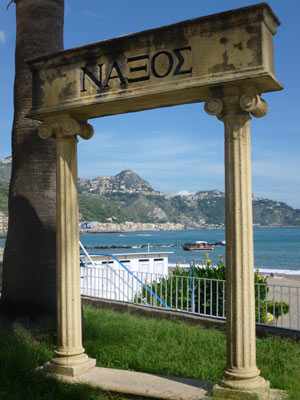
Giardini Naxos accommodation
Hotels and B&Bs
There’s a range of accommodation in Giardini Naxos, from standard Italian beach hotels to character-filled B&Bs. Some places have sea views, others have gardens and one or two of the larger hotels have swimming pools. Giardini Naxos is an unpretentious town and the same is true of its accommodation, with little B&Bs tending to offer the best holiday experiences. A number of holiday apartments offer a practical alternative to travellers planning a longer stay or a family holiday. Especially out of the peak summer months you can find some good prices. As you might expect in a beach resort, some accommodation is to a high standard and other places may provide minimal service; I’d recommend reading reviews attentively as well as checking the location.
Highlights include B&B Miramare, which offers bright sea views and Hotel Orpheus, which is on the rocks of the headland, right on the sea’s edge. Residence Villa Giardini offers self-catering studios in a complex with an outdoor pool.
> Hotels, B&Bs and apartments in Giardini Naxos
Highlights
Useful external links
Giardini Naxos hotels, B&Bs & apartments
